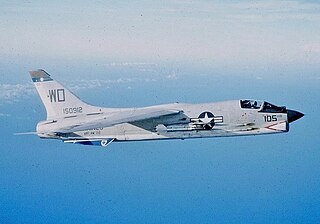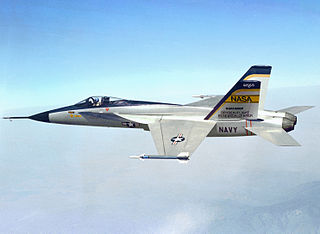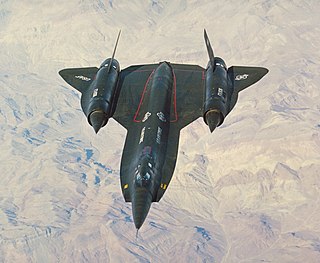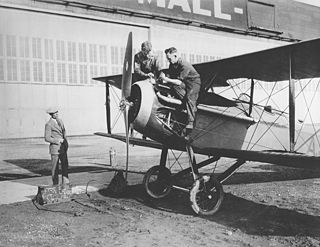
The Vought F-8 Crusader is a single-engine, supersonic, carrier-based air superiority jet aircraft designed and produced by the American aircraft manufacturer Vought. It was the last American fighter that had guns as the primary weapon, earning it the title "The Last of the Gunfighters".

The LTV A-7 Corsair II is an American carrier-capable subsonic light attack aircraft designed and manufactured by Ling-Temco-Vought (LTV).

The Northrop YF-17 is a prototype lightweight fighter aircraft designed by Northrop aviation for the United States Air Force's Lightweight Fighter (LWF) technology evaluation program. The LWF was initiated because many in the fighter community believed that aircraft like the F-15 Eagle were too large and expensive for many combat roles. The YF-17 was the culmination of a long line of Northrop designs, beginning with the N-102 Fang in 1956, continuing through the F-5 family.

The Lockheed YF-12 was an American Mach 3+ capable, high-altitude interceptor prototype, developed and manufactured by American aerospace company Lockheed Corporation.

The General Electric F110 is an afterburning turbofan jet engine produced by GE Aerospace. It was derived from the General Electric F101 as an alternative engine to the Pratt & Whitney F100 for powering tactical fighter aircraft, with the F-16C Fighting Falcon and F-14A+/B Tomcat being the initial platforms; the F110 would eventually power new F-15 Eagle variants as well. The engine is also built by IHI Corporation in Japan, TUSAŞ Engine Industries (TEI) in Turkey, and Samsung Techwin in South Korea as part of licensing agreements.

The Pratt & Whitney TF30 is a military low-bypass turbofan engine originally designed by Pratt & Whitney for the subsonic F6D Missileer fleet defense fighter, but this project was cancelled. It was later adapted with an afterburner for supersonic designs, and in this form it was the world's first production afterburning turbofan, going on to power the F-111 and the F-14A Tomcat, as well as being used in early versions of the A-7 Corsair II without an afterburner. First flight of the TF30 was in 1964 and production continued until 1986.

The Pratt & Whitney F100 is an afterburning turbofan engine designed and manufactured by Pratt & Whitney to power the U.S. Air Force's "FX" initiated in 1965, which became the F-15 Eagle. The engine was to be developed in tandem with the F401 which shares a similar core but with the fan upscaled for the U.S. Navy's F-14 Tomcat, although the F401 was later abandoned due to costs and reliability issues. The F100 would also power the F-16 Fighting Falcon for the Air Force's Lightweight Fighter (LWF) program.

Vought was the name of several related American aerospace firms. These have included, in the past, Lewis and Vought Corporation, Chance Vought, Vought-Sikorsky, LTV Aerospace, Vought Aircraft Companies, and Vought Aircraft Industries.

The North American F-107 is North American Aviation's entry in a United States Air Force tactical fighter-bomber design competition of the 1950s. The F-107 was based on the F-100 Super Sabre, but included many innovations and radical design features, notably the over-fuselage air intakes. The competition was eventually won by the Republic F-105 Thunderchief, and two of the three F-107 prototypes ended their lives as test aircraft. One is on display at the National Museum of the United States Air Force and a second at Pima Air and Space Museum.

The Yakovlev Yak-19 was a prototype Soviet fighter built in late 1940s. It was the first Soviet aircraft to be equipped with an afterburning turbojet, the Klimov RD-10F that was derived from the German Jumo 004 engine. Only two examples were built as it was rejected for service by the Soviet Air Force.

The Vought SBU-1 Corsair was a two-seat, all-metal biplane dive bomber built by Vought Aircraft Company of Dallas, Texas for the US Navy. Its design was based upon the F3U-1 two-seat fighter that was abandoned when the Navy decided not to obtain any more two-seat fighters.

The Lyulka AL-7 was a turbojet designed by Arkhip Mikhailovich Lyulka and produced by his Lyulka design bureau. The engine was produced between 1954 and 1970.

The Vought F6U Pirate was the Vought company's first jet fighter, designed for the United States Navy during the mid-1940s. Although pioneering the use of turbojet power as the first naval fighter with an afterburner and composite material construction, the aircraft proved to be underpowered and was judged unsuitable for combat. None were ever issued to operational squadrons and they were relegated to development, training, and test roles before they were withdrawn from service in 1950.

The Ling-Temco-Vought (LTV) XC-142 is a tri-service tiltwing experimental aircraft designed to investigate the operational suitability of vertical/short takeoff and landing (V/STOL) transports. An XC-142A first flew conventionally on 29 September 1964, and completed its first transitional flight on 11 January 1965 by taking off vertically, changing to forward flight, and finally landing vertically. Its service sponsors pulled out of the program one by one, and it eventually ended due to a lack of interest after demonstrating its capabilities successfully.

The Vought XF8U-3 Crusader III was an aircraft developed by Chance Vought as a successor to the successful Vought F-8 Crusader program and as a competitor to the McDonnell Douglas F-4 Phantom II. Though based in spirit on the F8U-1 and F8U-2, and sharing the older aircraft's designation in the old Navy system, the two aircraft shared few parts.

The Westinghouse J34, company designation Westinghouse 24C, was a turbojet engine developed by Westinghouse Aviation Gas Turbine Division in the late 1940s. Essentially an enlarged version of the earlier Westinghouse J30, the J34 produced 3,000 pounds of thrust, twice as much as the J30. Later models produced as much as 4,900 lb with the addition of an afterburner. It first flew in 1947. The J46 engine was developed as a larger, more powerful version of Westinghouse's J34 engine, about 50% larger.

The Vought/General Dynamics Model 1600 series was a fighter aircraft proposal designed for the United States Navy's Navy Air Combat Fighter (NACF) program. The Model 1600 was a carrier-based derivative of the General Dynamics F-16 Fighting Falcon, but lost to the Northrop/McDonnell Douglas F/A-18 Hornet.

The Pratt & Whitney F401 was an afterburning turbofan engine developed by Pratt & Whitney in tandem with the company's F100. The F401 was intended to power the Grumman F-14 Tomcat and Rockwell XFV-12, but the engine was canceled due to costs and development issues.





















